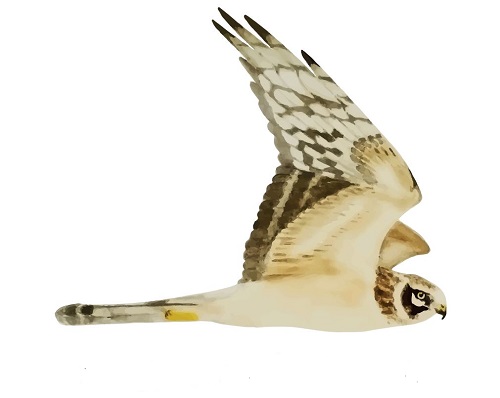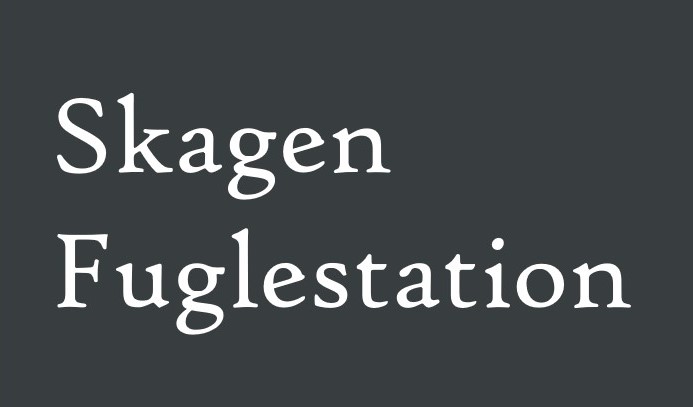Her på Skagen Fuglestations blog bringes korte nyheder i dagbogsformat om hændelser på fuglestationen.
Finding Joy in Slow, Foggy Days
Another day, another morning of fog. We woke up this morning, prepped and ready to go out to Grenen for a morning of counting at Worlds End 3, only to find the thick fog present once again. Unfortunately, this morning it was even thicker than the previous days, to the extent where we could hardly see the lighthouse tower 10 meters outside out window. That said, we were determined to make the most out of the day. We all decided to go back to sleep and check hourly if the fog would lift during our counting hours, however, it never did in that period of the day.
Waking up around 8:30 AM, we ate a nice breakfast in the kitchen and began to plan our day. Ragnar left to return back to Copenhagen this morning, but not to fret! He will return again later in the spring. By 9 AM we realized the fog likely would not lift until late in the day, so we rather opted to catch up on chores around the station. We first took a walk out to the radio telemetry station and cut the grass underneath the tower to prevent excess vegetation from building up. On the walk home, I decided to trek through the bog in Storsig and flushed two Common Snipe (Dobbeltbekkasin). We arrived back at the station around 1 PM and got the bikes out for a much needed deep clean. By 3 PM the fog finally lifted and Roman went for a short walk up towards the seal bunker.
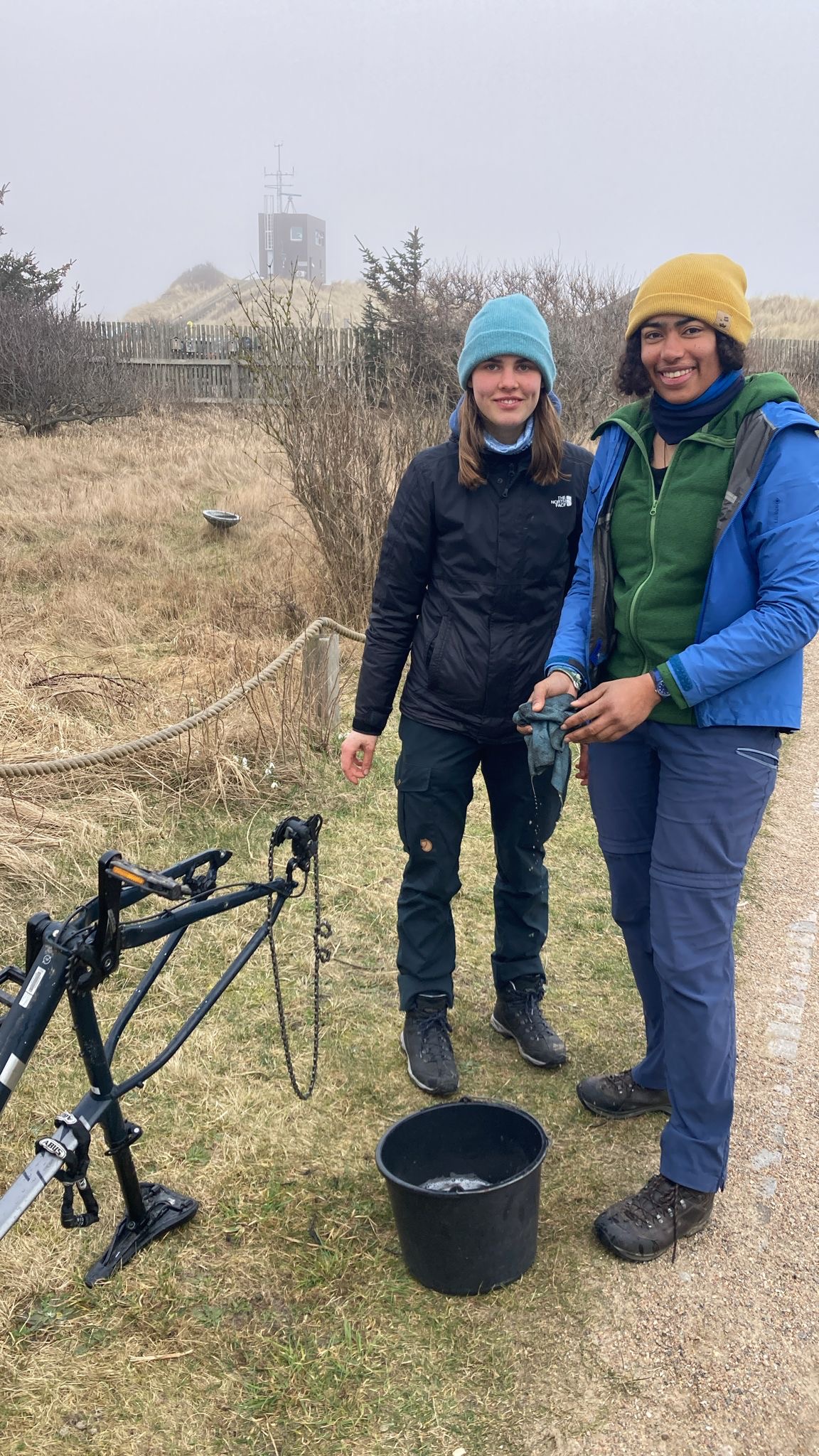
In the evening, we decided to do something a bit reckless and go for a swim! It was very cold as the water was approximately 3,5 C, but it was very refreshing. Later in the evening we checked the stations email and found that a Norwegian Bird Station has been documenting the same leucistic Rock Pipit (Skærpiber) that Ragnar and I documented a few days before. According to the email, it was first found in 2019 and has been recorded every year for the past 6 years!
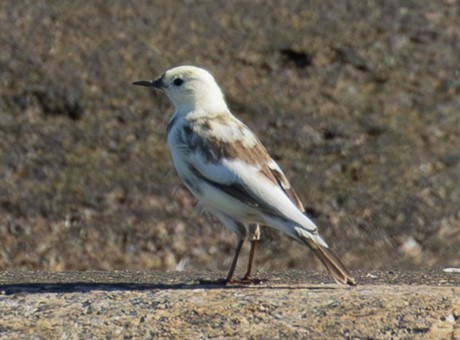 The Skærpiber in 2024 photographed by Store Færder Ornitologiske Stasjon
The Skærpiber in 2024 photographed by Store Færder Ornitologiske Stasjon
You can find a pictue from when it was here in Skagen in the blog post from the 8th March.
In the evening we welcomed Mara to the station once again! She will join us here for the next three weeks before she returns to university in Germany. Now, we are finally preparing for a morning without fog. For the first time in 4 days, fog is not forecasted to be preset in Skagen due to some north wind! We hope the big migration day we have been waiting for arrives! And so, another day passes at Skagen Fuglestation. What will tomorrow bring? We will have to wait and see!
Highlights:
- Common Snipe (Dobbletbekkasin)
- Razorbill (Alk) flocks
- Cleaning the bikes!
Link to today’s observations in Dofbasen in the Skagen area
Sum of the Raptors in the area based on observations typed into Dofbasen.
People: Lucas Corneliussen, Simon Sigaard Christiansen, Cora Köberle, Janna Ouedraogo, Roman Spilldooren, Ragnar Smith, Mara Glane
The Fog Cleared Up and the Birds Liked It!
The day started with a thick layer of fog. Most of us took the time to catch up on some extra sleep in the morning, but Janna opened the net in the garden of the lighthouse. The first catch of the day were two Common Blackbirds (Solsort), one of which had been with a radio transmitter. It was a bird that had been caught and given a transmitter in Skagen on the 14 the of January 2024. We also received response that one of the blackbirds (Solsort) which was ringed in Skagen on the 18 of November sent a signal from West Finland!
Around 11 o'clock, the fog started to lift. Ragnar and Lucas immediately headed out to Grenen and found a Rough-legged Buzzard (Fjeldvåge). So, we all set off together for World's End 1. En route to World's End 1 we found the first really good numbers of sunbathing Adders. When we arrived, the passerine migration appeared to be still going on and there were also a few dozen common buzzards (Musvåge) attempting to migrate. The sea was completely smooth, which made it perfect for scanning the seaducks and to try and find marine mammals. Among the groups of migrating Starlings (Stær), Finches (bogfinke) and Siskin's (Grønsisken), we saw remarkably many Wood Larks (Hedelærke) attempting to migrate. We saw as many as 18, migrating across the dunes to the north. After counting migration for a while, Ragnar rediscovered the adult male King Eider (Kongeedderfugl)! A lifer for Cora and for many, the first adult male they have ever seen. What an impressive species! When Lucas walked towards the King Eider (Kongeedderfugl) for closer observation, he refound the second King Eider (Kongeedderfugl)! This time a 2k male. We all grabbed our gear and ran onto the beach to admire these two beauties.
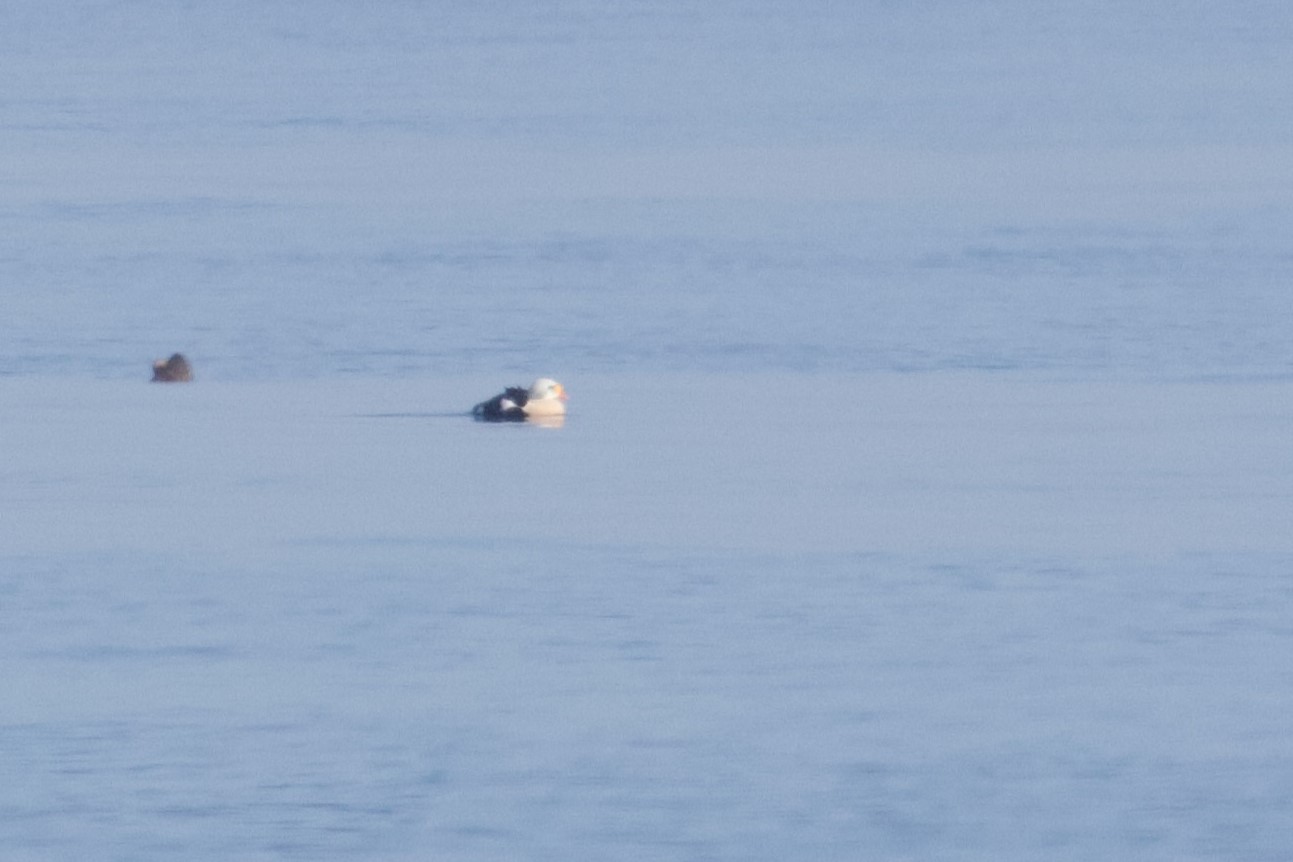 Adult male King Eider (Kongeederfugl)
Adult male King Eider (Kongeederfugl)
When we were at the beach, the new birds kept coming. Ragnar found a nice adult Black guillemot (Tejst) and the buzzards started to migrate above us. We then found a second (this time darker) Rough-legged Buzzard (Fjeldvåge). Everyone was very happy with all these cool species and sightings and being in such a good mood, we decided to try our luck at the migration watchpoint once again. When we arrived, our luck apparently couldn't run out as we found a pod of Dolphins but unfortunately, they were too far away to make the determination to species level. In a group of Barnacle Geese (Bramgås), we found 4 Taiga bean geese (Tajgasædgås) going straight over our heads.
We then decided to take advantage of the flat sea and do a good scan of the sea ducks. There, we found a Red-necked Grebe (Gråstrubet lappedykker) and a few Fulmars (Mallemuk). The good species apparently couldn't stop today as we suddenly heard a call of a Twite (Bjergirisk)! The first we saw this season! That was a lifer for Lucas and me. We decided to finish the day and left for Skagen to do some shopping.
When we got back to the station Simon had arrived at the station. We decided to take advantage of the last light, and it turned out to pay off. We saw some groups of Razorbills (Alk) and Guillemots (Lomvie) migrating in the Kattegat and a Bewick's Swan (Pibesvane) came flying over our heads (a species seen only a few days a year in Skagen). Suddenly we heard Ragnar say that he might have found something very good. He pointed out to us a group of Mallards flying far over the sea. Among the Mallards there was a duck flying that had feature of American Black Duck (Sortbrun And)! Unfortunately, the bird was flying too far to take good documentation photos, hopefully we will find it tomorrow. With that thought, we quickly crawled into our beds as it had been a long day and tomorrow looks promising.
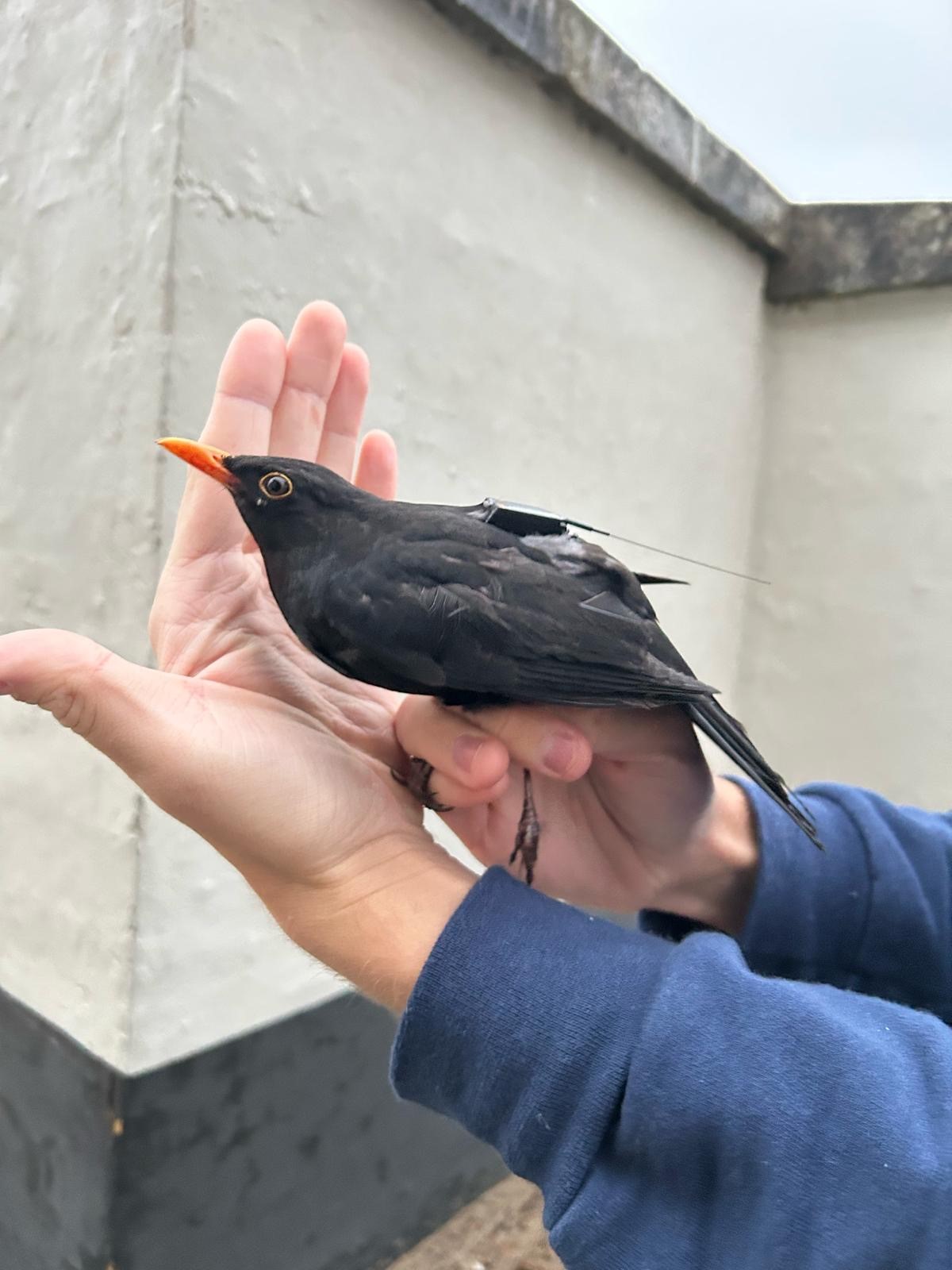 The Blackbird (Solsort) with tag we recaught!
The Blackbird (Solsort) with tag we recaught!
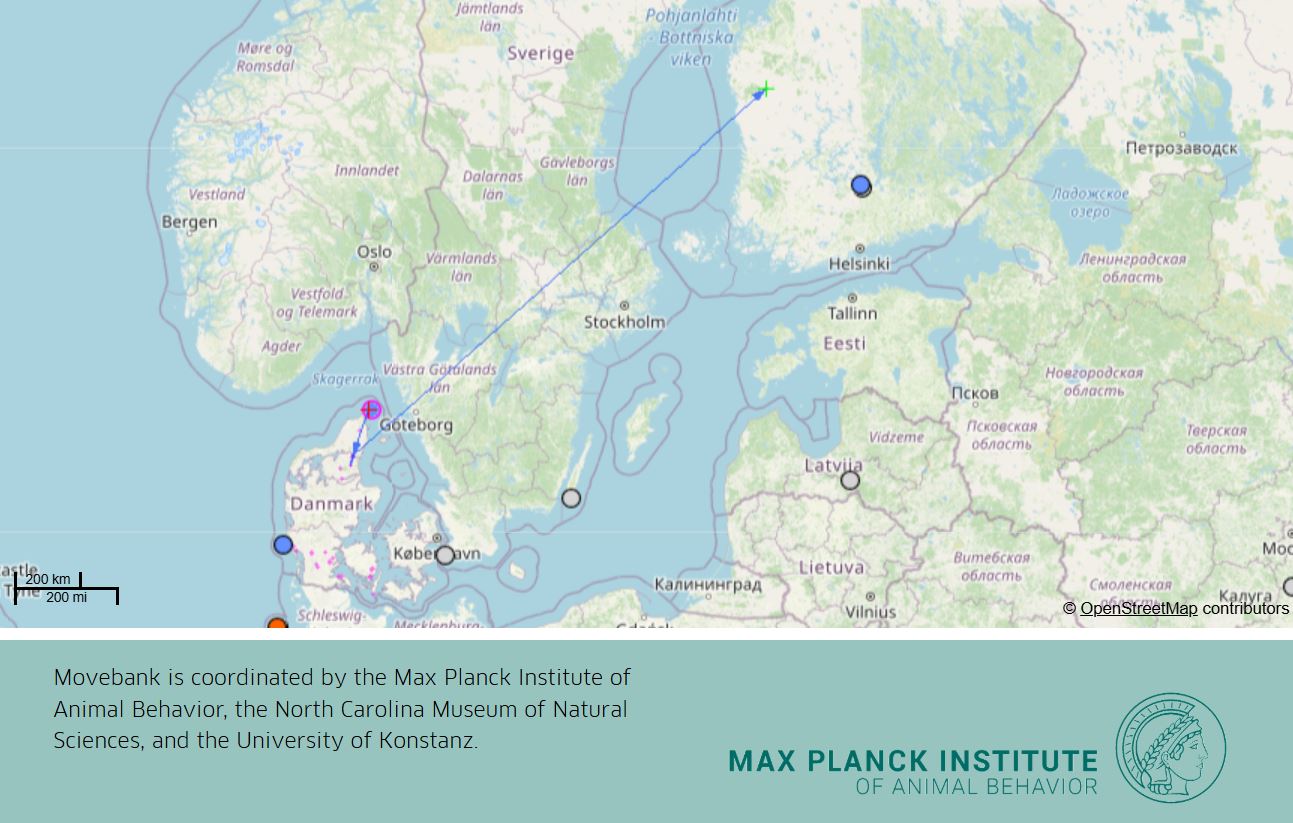
Highlights from the observations:
- 2 King Eider (Kongeedderfugl)
- 2 Rough-legged buzzard (Fjeldvåge).
- 1 Bewick's Swan (Pibesvane)
- 18 Woodlark (Hedelærke)
- 4 Taiga Bean geese (TajgaSædgås)
- Blackbird (Solsort) with radio transmitter
- Dolphin sp.
Ringing (Fyrhavn)
- Blackbird (Solsort) 1
- Chaffinch (Bogfinke) 2
Link to today’s observations in Dofbasen in the Skagen area
Sum of the Raptors in the area based on observations typed into Dofbasen.
People: Lucas Corneliussen, Simon Sigaard Christiansen, Cora Köberle, Janna Ouedraogo, Roman Spilldooren, Ragnar Smith
Foggy but Funny
It was very foggy the whole day today. It was so foggy that we could not see the sea when looking out of the window the whole day. So we could not do the migration count today. Instead we started the day really chilled. Later we cleaned a bit and had a fun ping pong tournament.
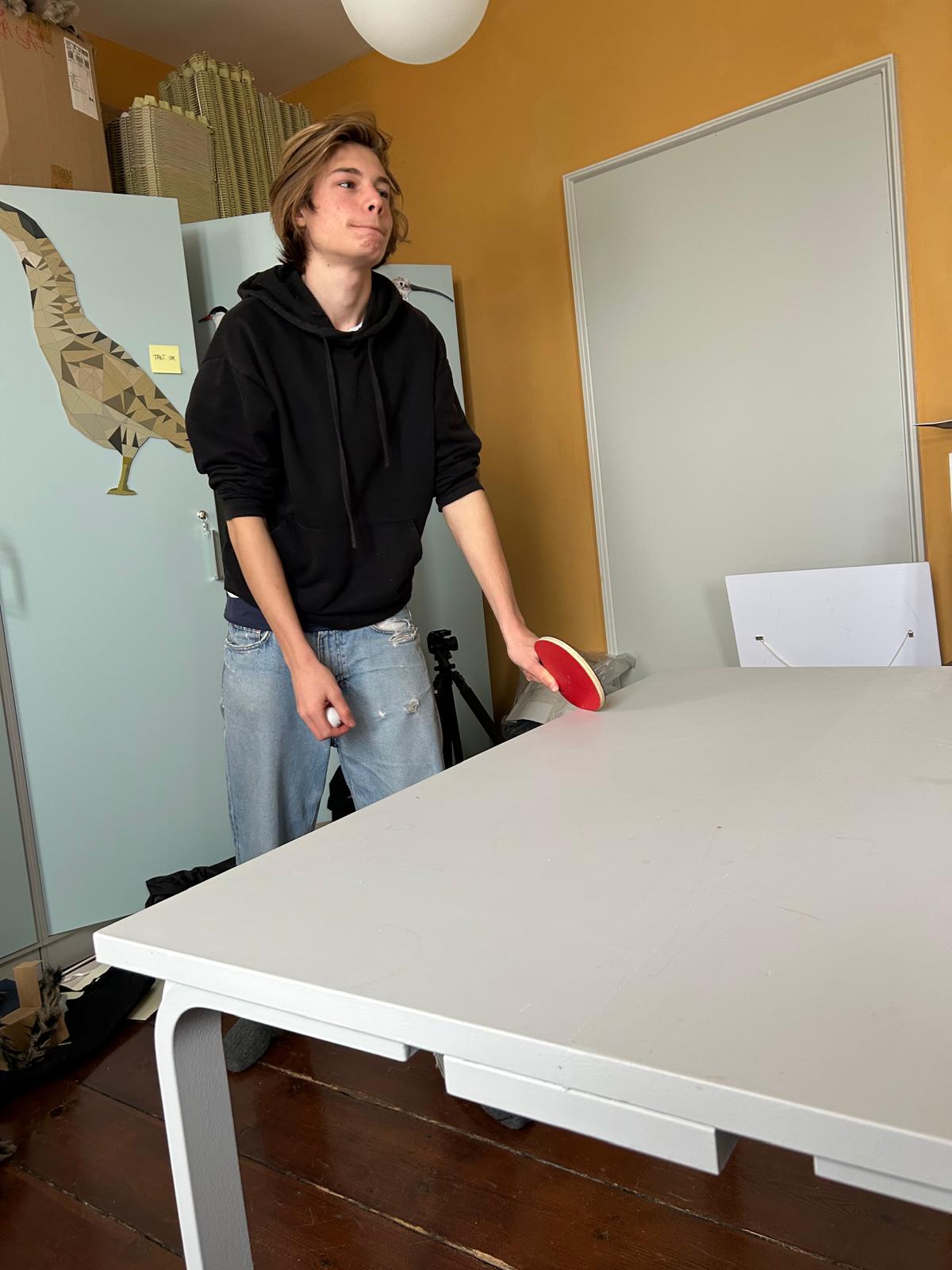 Palning the perfect table tennis serve
Palning the perfect table tennis serve
We noticed some thrushes in the garden and put some apples out. After that we opened the net in the garden to catch some birds. When we checked the net an hour later a female Blackbird (Solsort) had flown in. Roman ringed it. It was his first time he has rung a bird.
Later Lucas and Ragnar went out for a walk. They found a nice Short-eared Owl (Mosehornugle) and more than 60 Rock Pipits (Skærpiber)! Between the Rock Pipits they found a really weird looking bird, which, as it turned out, was a leucistic Rock Pipit!
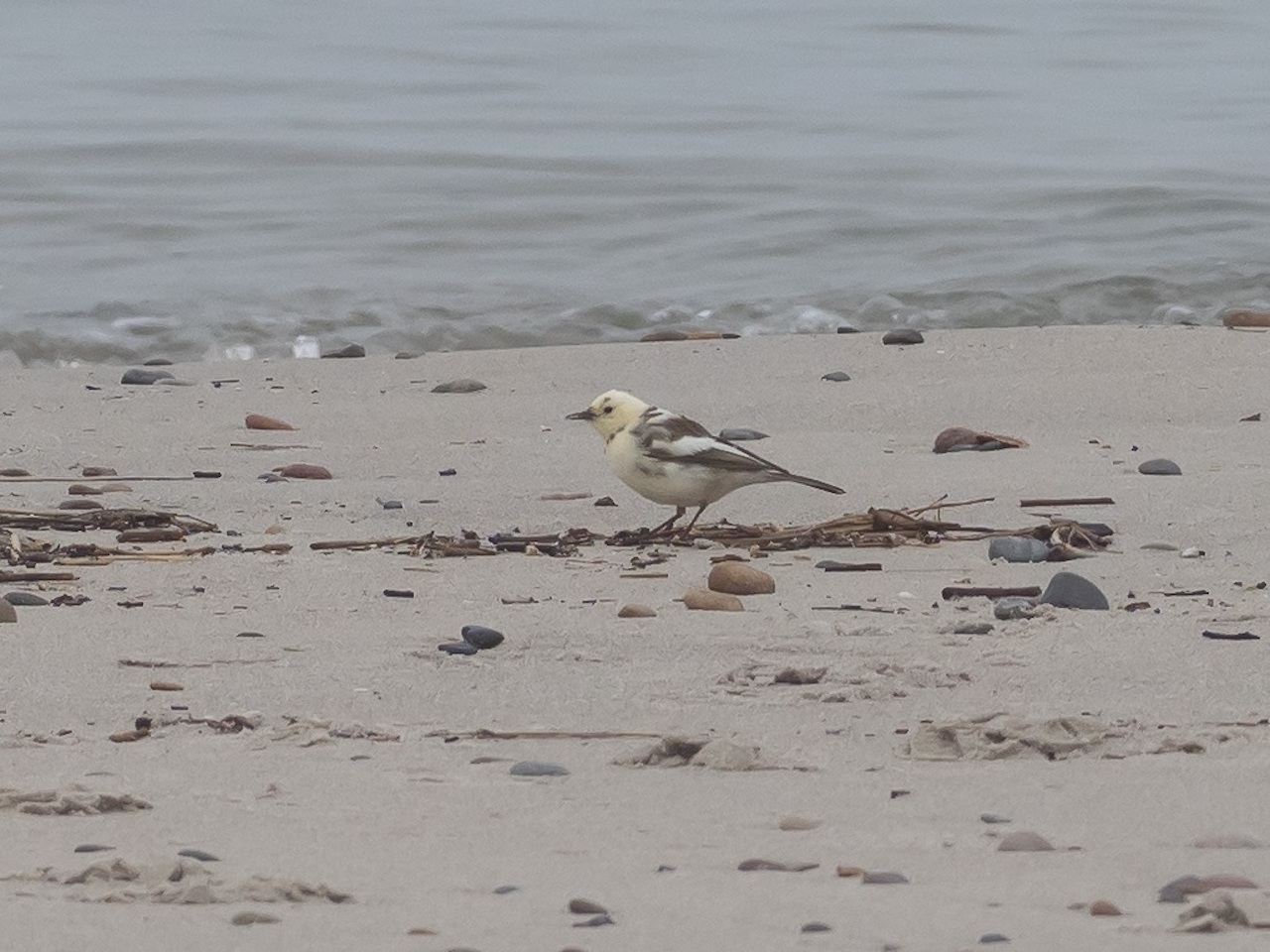 Wierd looking leucistic Rockpipit
Wierd looking leucistic Rockpipit
In the afternoon Simon came to take us to the harbour to feed the Gulls. There were not as many Gulls as last time but it was really nice again to see them so close. And we found again a Caspian Gull. Quote from Ragnar “There is no day in Skagen where you don't see a Caspian Gull”.
When we came back we played a nice round of “Wingspan”. Roman won it.
Now the plan is to go night catching later. I’m really looking forward to catching some nice birds. Unfortunately the weather forecast predicts more fog for tomorrow, but we will see.
Ringing (Fyrhavn)
Solsort 1
Highlights:
Short-Eared Owl (Mosehornugle)1
Caspian Gull (Kaspik Måge)1
Rock Pipits (Skærpiber) more than 60
leucistic Rock Pipit (Skærpiber) 1
Link to today’s observations in Dofbasen in the Skagen area
Sum of the Raptors in the area based on observations typed into Dofbasen.
People: Lucas Corneliussen, Simon Sigaard Christiansen, Cora Köberle, Janna Ouedraogo, Roman Spilldooren, Ragnar Smith
No Rest for the Wicked
We have been hoping, planning and preparing for this day to come. For over a week the volunteers at the station have been watching the weather and noticed that for the first time in many days, the wind has slowed dramatically down from 14 m/s to 5 m/s (SW). With that we were expecting good things.
Waking up at 6 AM with the hopes of reaching Worlds End 3 fifteen minutes before dawn, we quickly hopped on our bikes and cycled quickly out. Arriving with time to spare we waited. And not long after, it started. Passerines began to fly over us in great numbers, with nearly 2000 Jackdaw (Allike) in the first hour and lots of Reed Buntings (Rørspurv), Eurasian Siskins (Grønsiskin), European Starlings (Stær) attempting to migrate. The first hour was also quite hectic with waterfowl with many geese migrating Northeast towards Sweden. Greater White-fronted Geese (Blisgås) comprising the majority of the flocks, but also including good numbers of Barnacle (Bramgås) and Pink-footed Geese (Kortnæbbet Gås). The sea, however, was quite slow this morning as visibility was quite bad further offshore, but a nice Black Guillemot (Tejst) and a male Long-tailed Duck (Havlit) made up for it.
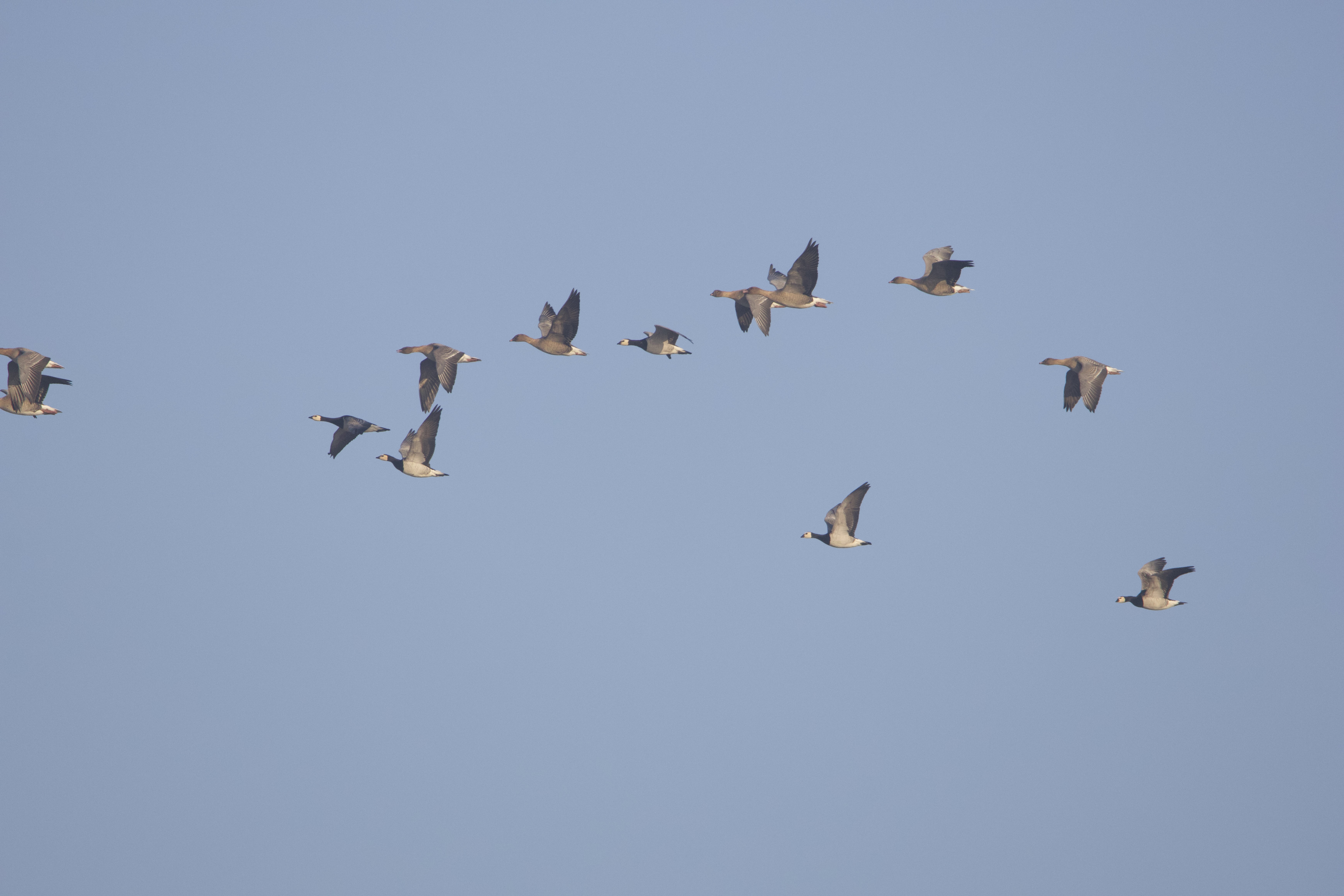 Pink-footed and Barnacle Geese migrating!
Pink-footed and Barnacle Geese migrating!
By mid-morning the passerine migration was beginning to wind down, but with the light southwesterly wind, many buzzards began to attempt to migrate via Grenen. We tallied 146 total Common Buzzards (Musvåge). We also got the first Eurasian Goshawk (Duehøg) of the season, a 2cy. individual quickly flew over near Worlds End 1 attempting to migrate. Further we also had several Red Kites (Rød Glente), one of which had a GPS tag on it. It was ringed and tagged on Fyn the 26th June 2023 by Hans Rytter as a young bird in nest. Which mean it's now a 3cy. Since it was ringed it has been on a trip to northern Spain. The bird is part of the project EuroKite. On their website you can find latest positions on their tagged Kites.
We opted to stay and extra 45 mins at the observation point as the buzzard migration continued, and fortunately for us we did as a Shore Lark (Bjerglærke) attempted to migrate over our heads. A lifer for Cora.
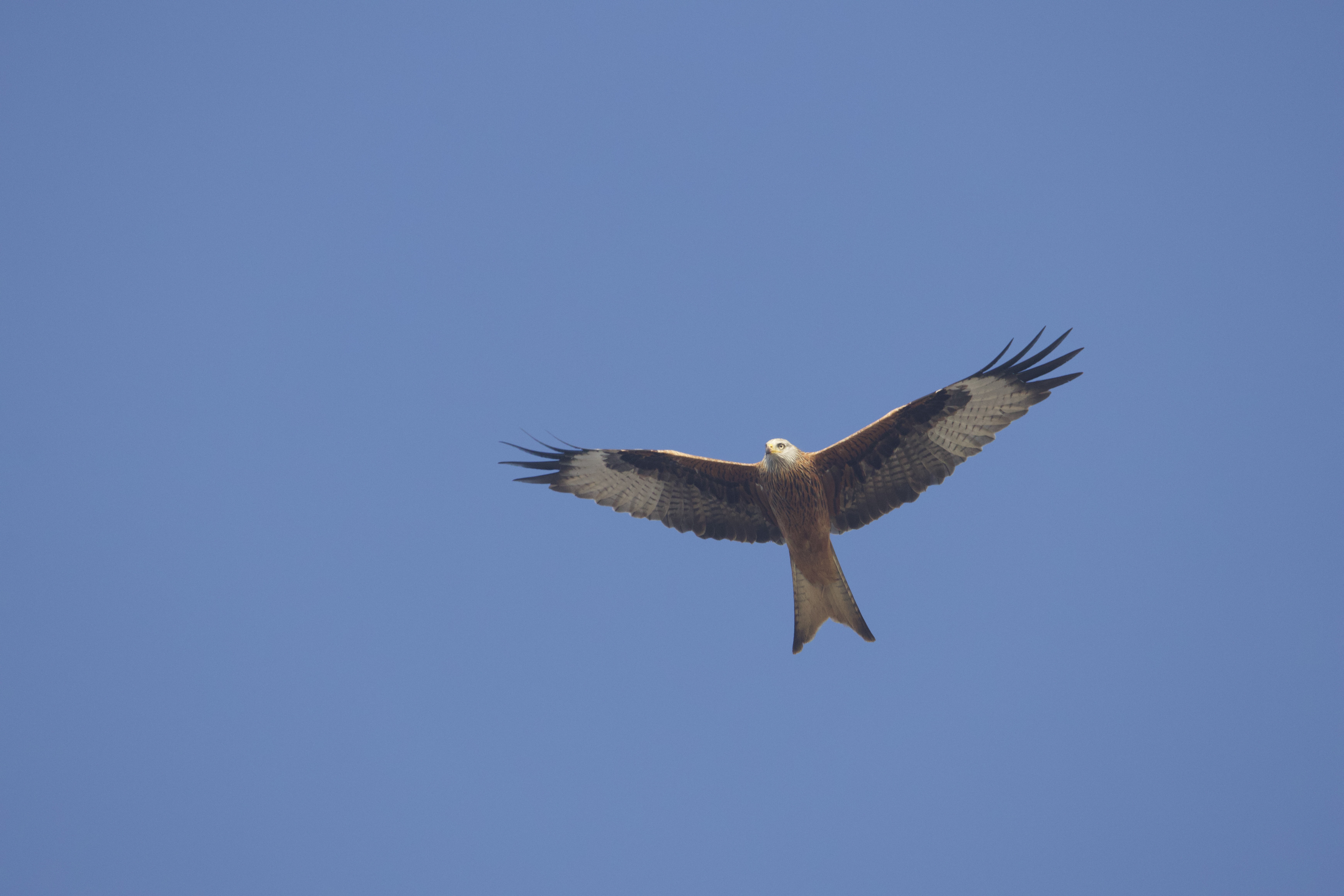 Red Kite, part of the raptor show!
Red Kite, part of the raptor show!
Heading back to the station at 11:45, Ragnar and I took a small detour and decided to spend a bit of time birding in Elle Krattet in search of vagrant woodpeckers and early migrants. We ended up finding a few Crested Tits (Topmejse), two or three Eurasian Treecreepers (Træløber) and accidentally flushed a Eurasian Woodcock (Skovsneppe). We then returned to the station and right as we were walking inside a White-tailed Eagle (Havørn) flew over headed towards Grenen.
When we finally got inside, we quickly did our morning data and then headed back out to bird around Storsig and Jennes Sø. We did not find anything too crazy, but a pair of Common Cranes (Trane) were nice as well as some lingering raptors from earlier in the day.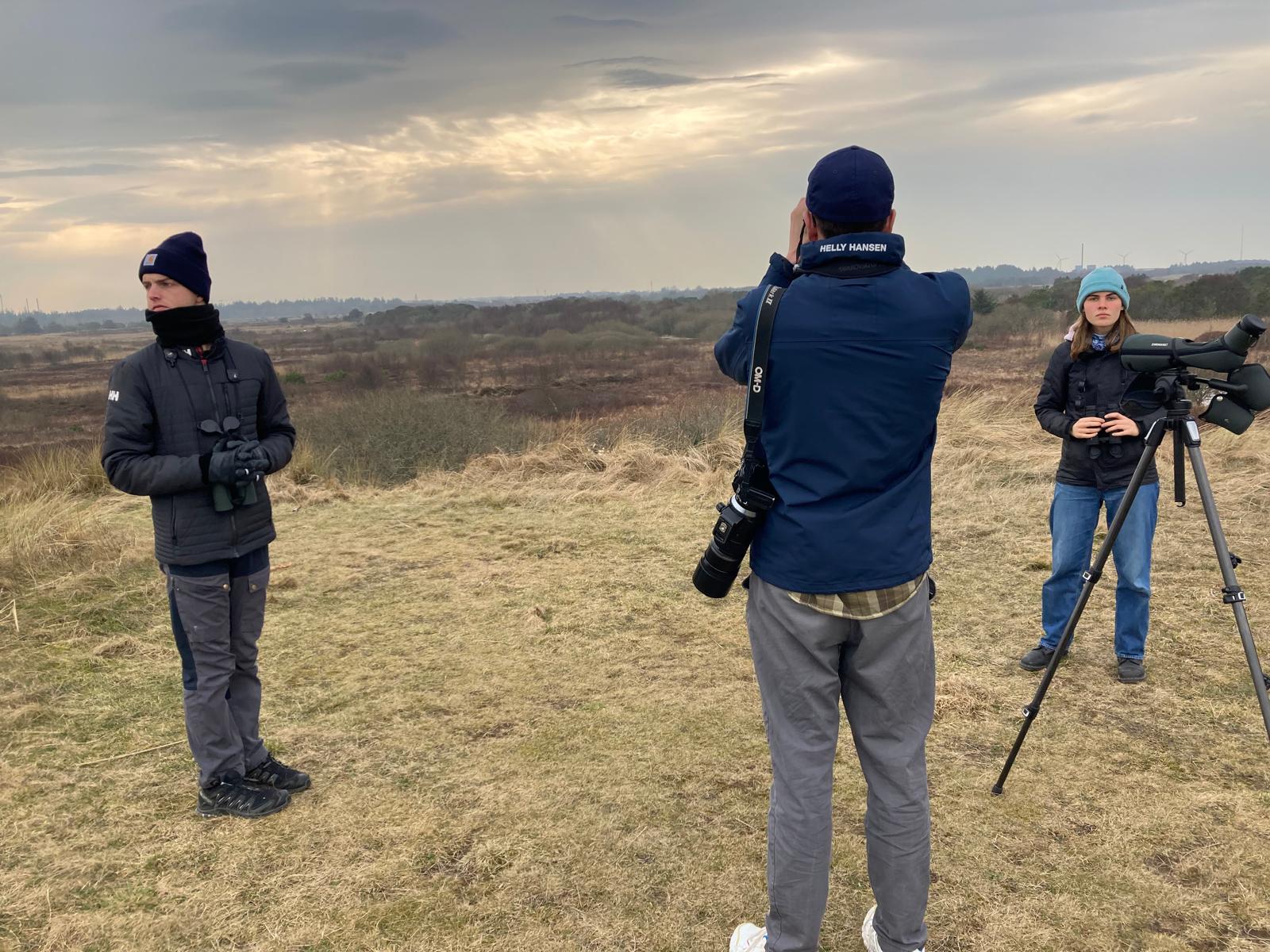 Out on the walk to Jennes Sø
Out on the walk to Jennes Sø
Now we are preparing to head out this evening to try and do some nocturnal ringing with the hopes of finding snipes and woodcocks! But with the weather looking even better tomorrow morning than today we may not be out all that late!
And so another day passes at Skagen Fuglestation, what will tomorrow bring? We will have to wait and see!
Highlights:
- Long-tailed Duck (Havlit)
- Horned Lark (Bjerglærke)
- Common Buzzard (Musvåge) - 150+
- White-tailed Eagle (Havørn)
- Treecreeper (Træløber)
- Glaucous Gull (Gråmåge) - same bird as the last few days
- Caspian Gull (Kaspisk Måge) - 1 (2k), 1 adult
- Eurasian Goshawk (Duehøg)
Link to today´s observations in Dofbasen in the Skagen area
Sum of the Raptors in the area based on observations typed into Dofbasen.
People: Lucas Corneliussen, Simon Sigaard Christiansen, Cora Köberle, Janna Ouedraogo, Roman Spilldooren, Ragnar Smith
Migration starts again
Sitting at the breakfast table we could already hear the wind blowing very strongly. We therefore thought it would become a day with almost no migration. We talked a bit about our wishes for the day-horned lark (Bjerglærke) or how about a white-billed-diver (Hvidnæbbet Lom)? We saw none of them, however it still was a day full of highlights.
On our way to the counting point, we already registered some movement in the air. It continued when we started our counting and especially in comparison to yesterday´s count it was a good migratory day. The birds arrived blow upon blow. It was almost hard to detect all the incoming swans. In the four hours we counted almost 500 whooper swans (Sangsvane) that tried to migrate.
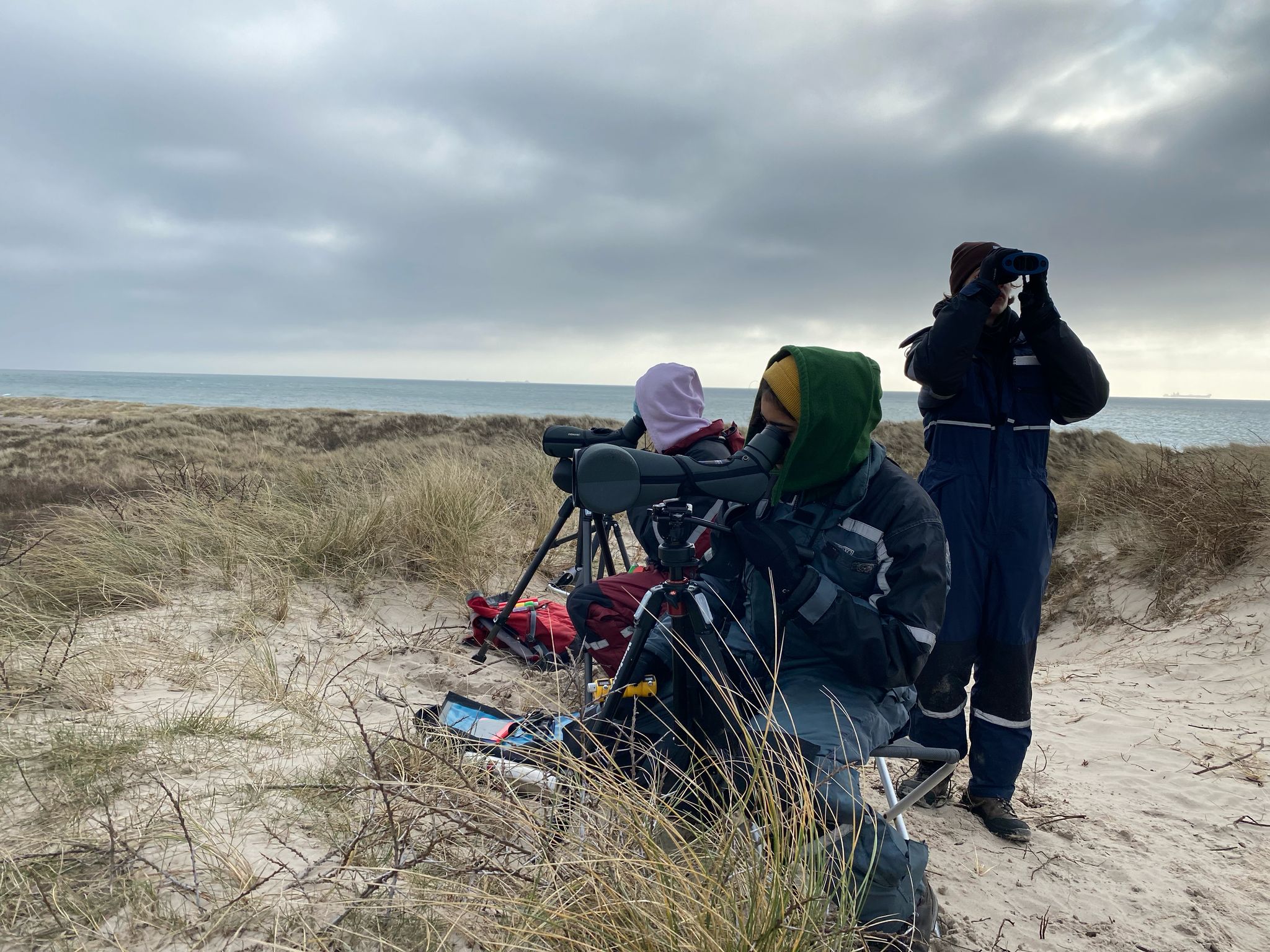 Counting birds all over the place
Counting birds all over the place
During our count a yellowhammer (Gulspurv) appeared only four meters away from us and we could watch it very well. In the morning, we also had many migrating passerines. There we were able to see some new species for our Skagen list.
It was not that cold and in the end of our countings the sun appeared. That was nice and also motivated some raptors to fly over. In the end of our count we saw at least 28 common buzzards (Musvåge) in the sky. Due to the warm weather there were also some other animals. We could watch an adder (Hugorm- Vipera berus) and a moor frog (Spidssnudet frø-Rana arvalis).
In the evening we did our fulmar survey for the week. For that we walked on the beach, looking out for dead fulmars (Mallemuk). We could not find any, instead we found some dead porpoises (Marsvin). On the beach we also found a 3cy. (3k) glacous gull (Gråmåge) eating a seal and feathers from a dead Barn Owl!
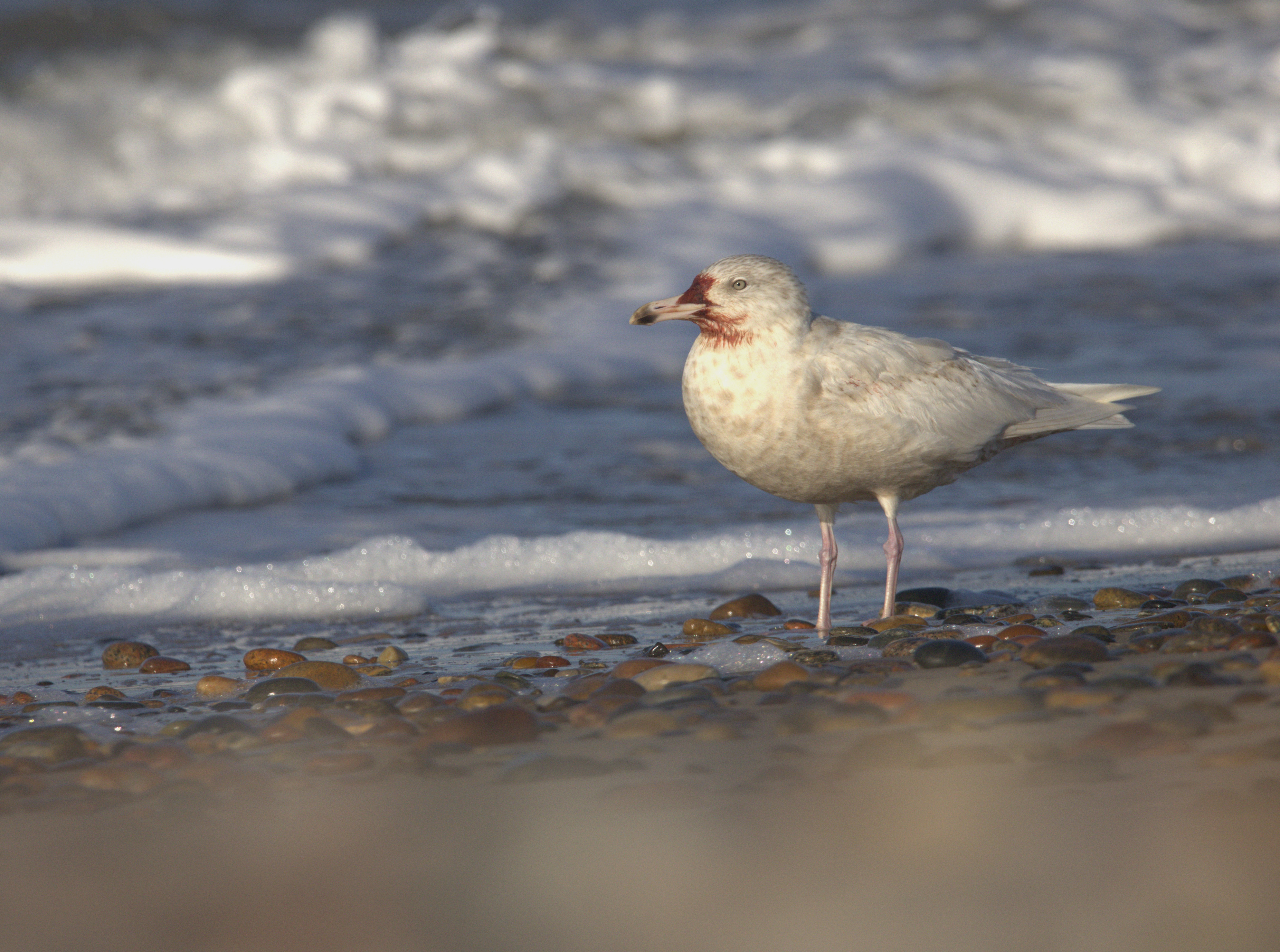 Glaucous gull still with bloody face photographed by Roman
Glaucous gull still with bloody face photographed by Roman
We had put some apples in the garden for the thrushes. When we came back from the survey some of them disappeared and we could watch some birds feeding on them. In the evening Ragnar Smith arrived on a visit the next couple of days.
The weather forecast for tomorrow looks very good so we are looking forward to a nice day of birding. Our oracle predicts some interesting species for tomorrow.
Highlights
- 2 Great-northern-diver (Islom)
- 1 Glaucous gull (Gråmåge)
- 5 bewick's swans (Pibesvane)
- 1 Pochard (Taffeland)
- 57 species during the count
Link to today´s observations in Dofbasen in the Skagen area
Sum of the Raptors in the area based on observations typed into Dofbasen.
People: Lucas Corneliussen, Simon Sigaard Christiansen, Cora Köberle, Janna Ouedraogo, Roman Spilldooren, Ragnar Smith
Persistence is Key
We were up again today well before the sun appeared on the horizon. As predicted, the sun lost the battle with the clouds and it turned into another windy cloudy day. The weather did not look too good but the atmosphere was good so everyone was looking forward to a day at World's End I.
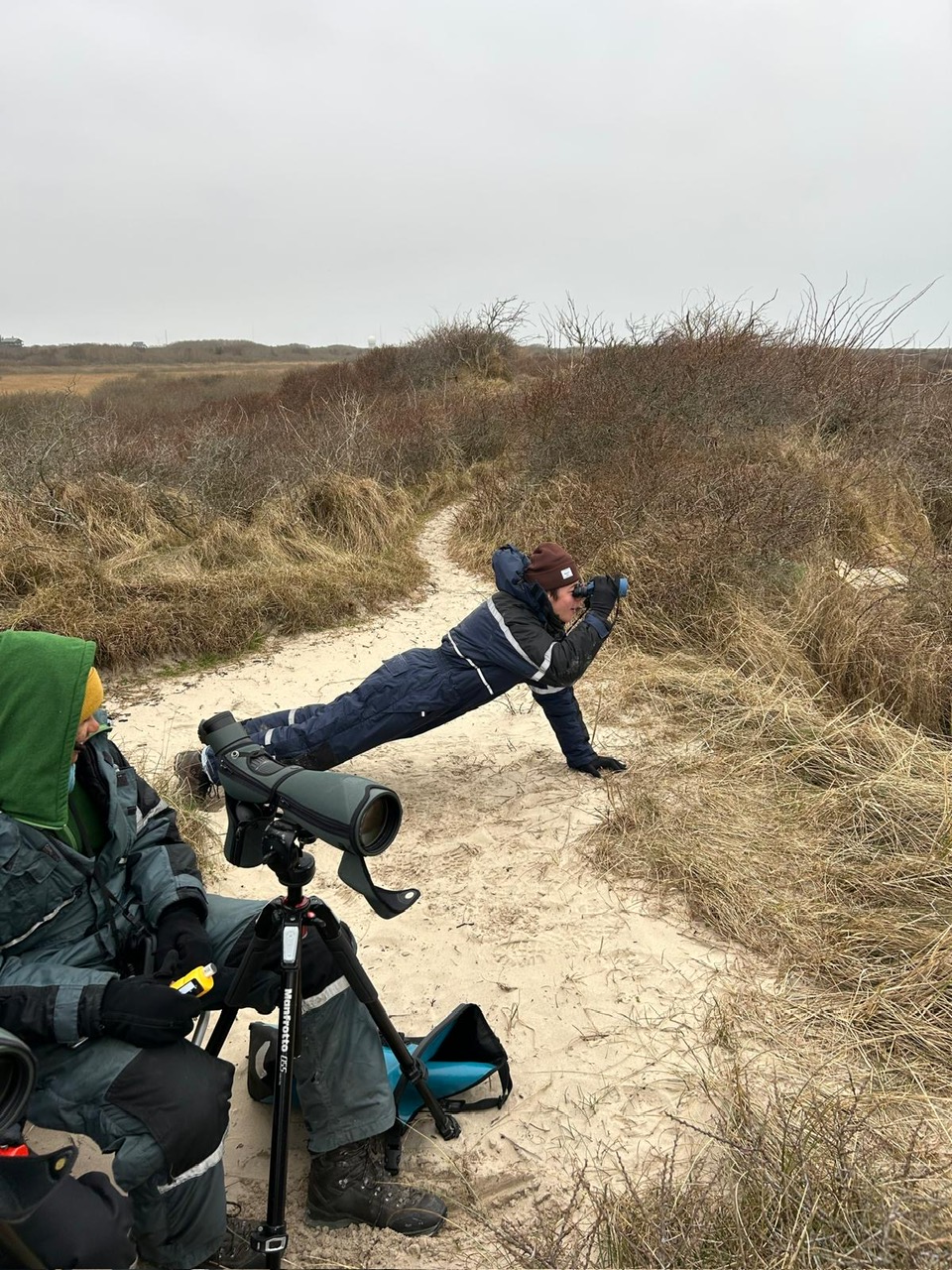
At sea there were decent numbers of scoter's, Gannet's (sule), Red-throated diver's (Rødstrubet lom), Black-legged Kittiwake’s (Ride) flying. The surprise of the day today came in the form of a Horned Lark (Bjerglærke) unfortunately only Lucas saw it but it is a nice new species for the counts.
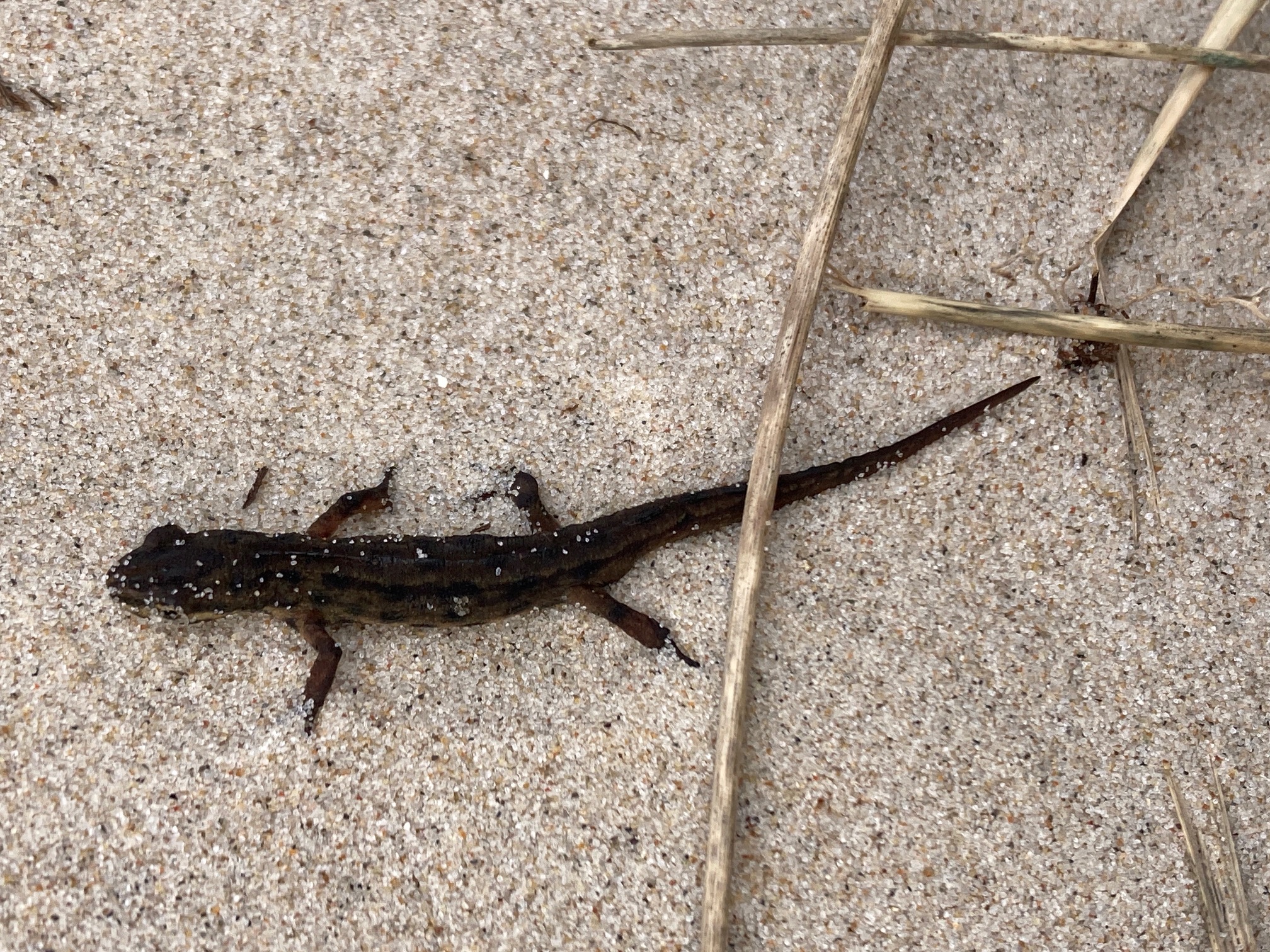
I counted the birds that came from inland so mainly the passerines, raptor's and waterfowl. But with a shortage of birds to count i invented the migration watch workout. It is very good for exercising once in a while and is recommended against the cold (of course, all species are still counted and the rest take your species during the workout). So there are several exercises you can do such as; the scan and Squat, the binocular-check push up, the scope bicep curl.
When returning to the lighthouse found several amphibians such as moorfrog (Spidssnudet frø) and Smooth Newt (Lille vandsalamander). Once back at the station, Simon picked us up for a trip into the village to buy new bikes. We rode back by bike and this time the very strong south-westerly wind played in our favour! Even on a little too small bike, we flew back to our station.
All ready to go back counting tomorrow morning!
Hightligts from the observations:
Horned Lark (Bjerglærke)1
Black Throated Diver (Sortstrubet Lom) 1
Link to the observation in Dofbasen in the Skagen area
Sum of the Raptors in the area based on observations typed into Dofbasen.
People: Lucas Corneliussen, Simon Sigaard Christiansen, Cora Köberle, Janna Ouedraogo, Roman Spilldooren.
More Passerine Migration and some nice Gulls
We planned to go to the bunker for the migration count because of all the wind. But when we came there we decided to go to Worlds End1 to have a better view on the migration birds. That was a really good decision!
There were more passerines migrating today. Five Parrot Crossbills (Stor Korsnæb)and Lucas also saw some Waxwings (Silkehale). There were also more than 2000 Jackdaws (Allike) migrating today. We also had some Bean Geese (Tajgasædgås/Tundrasædgås) and one Blackthroated Diver (Sortstrubet Lom). There were also more raptors migrating today. It was a really nice migration count this morning.
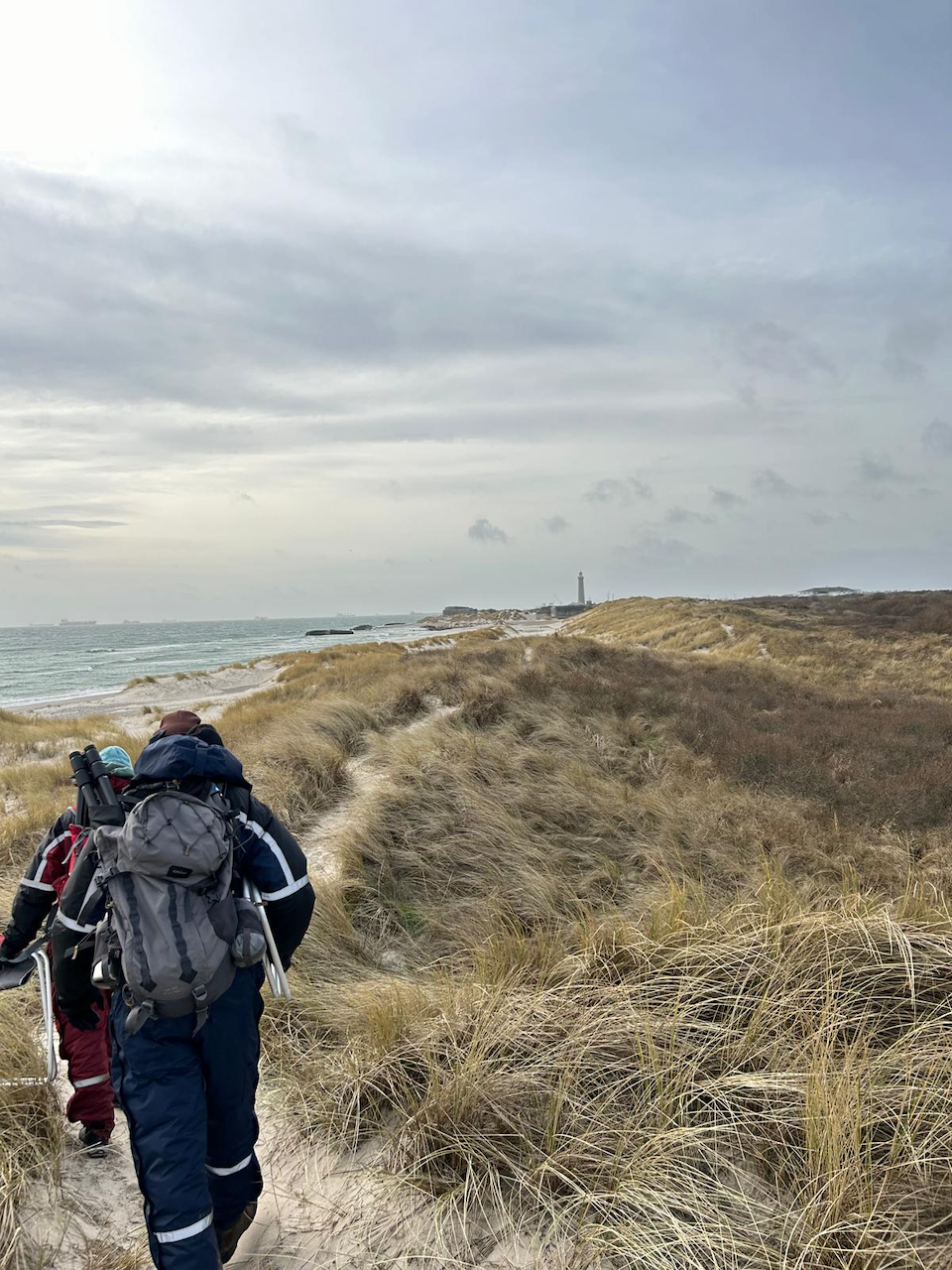 Walking back to the Lighthouse
Walking back to the Lighthouse
Later in the afternoon Simon picked us up and we went to the Harbour to feed the Gulls. There we found two colour ringed Herrring Gulls (Sølvmåge) which were ringed in Norway. And a reallynice Viking Gull which is a hybrid between Herring Gull (Sølvmåge) and Glaucous Gull (Gråmåge).
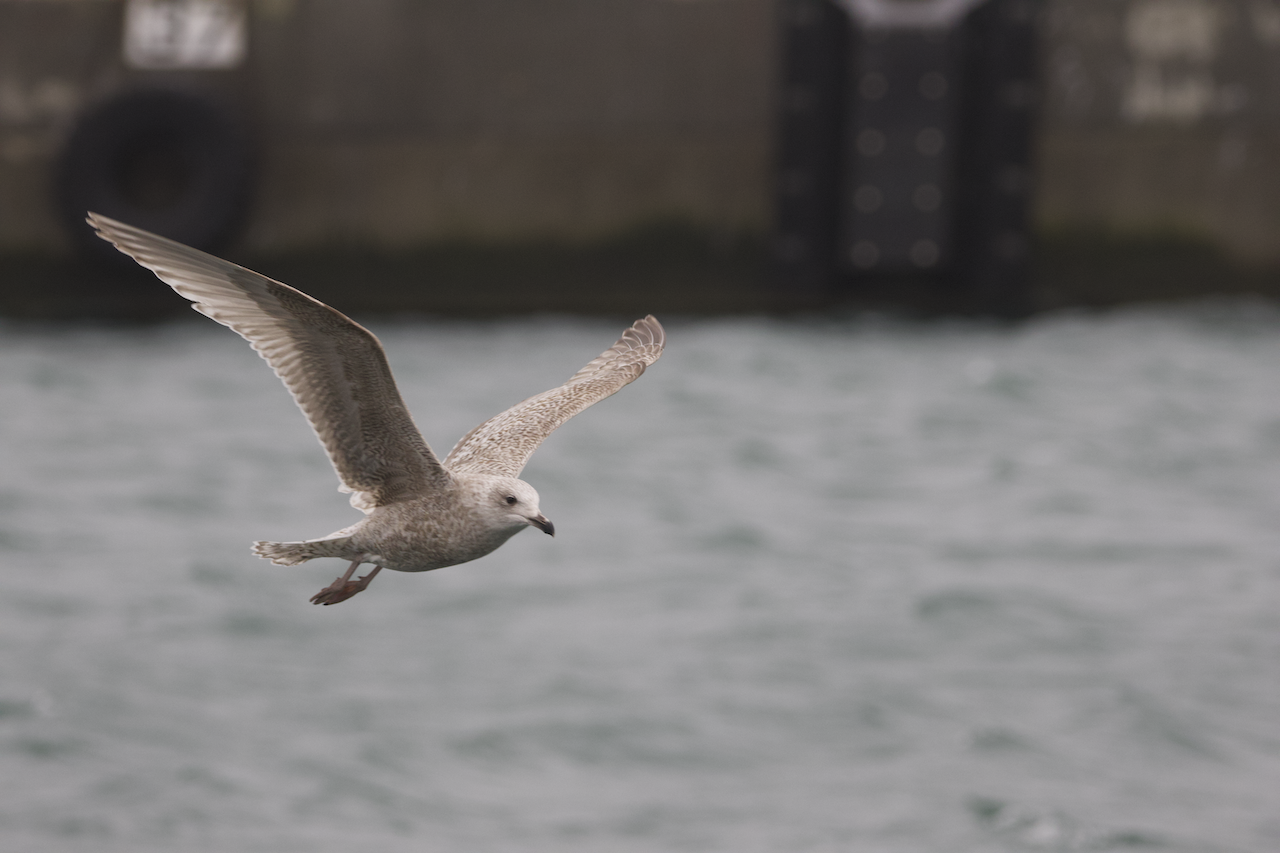 Viking Gull (Gråmåge x Sølvmåge) in the harbour
Viking Gull (Gråmåge x Sølvmåge) in the harbour
We also found four Caspian Gulls (Kaspik Måge). It was really nice to have so many Gulls so near by.
 Having fun with feeding the Gulls
Having fun with feeding the Gulls
After feeding the Gulls we went to the mole. On the way there we saw some more Gulls hanging around on the ground. We stopped to take a closer look at them and found a beautiful 3k Glaucous Gull (Gråmåge) which unfortunately flew away with some other Gulls but we found it again just a few meters further.
It was really windy at the Mole but Roman found a Long Tailed Duck (Havlit) which was a decent final bird for this trip.
Hightligts from the observations:
Parrot Crossbills (Stor Korsnæb) 5
Bean Geese (Tajgasædgås/Tundrasædgås) 10
Waxwings (Silkehale) 7
Black Throated Diver (Sortstrubet Lom) 1
Glaucous Gull (Gråmåge) 1 3k
Vikinggull (Gråmåge x Sølvmåge) 1 2k
Link to today's observations in Dofbasen in the Skagen area
Sum of the Raptors in the area based on observations typed into Dofbasen.
People: Lucas Corneliussen, Simon Sigaard Christiansen, Cora Köberle, Janna Ouedraogo, Roman Spilldooren.
Wind & White Caps
We knew it was coming. The strong winds from the west picked up today as expected, but not in the way we envisioned. With our alarms waking us up at 6 AM, we quickly ate a nice breakfast and packed some coffee for the road and cycled out to Grenen. Arriving just after 7 AM, we were greeted by a small flock of Whooper Swans (Sangsvane) migrating north towards their breeding grounds in northern Scandinavia. The first of many in the morning. Fortunately, the wind had not quite picked up the way we were expecting and the crew had several good hours of counting without the elements interfering dramatically.
 The morning watch
The morning watch
The surprise of the morning was a 2k (1st cycle) Iceland Gull (Hvidvinget Måge) found amongst the large gull flock at the end of the Sandormentrak. Unfortunately, only a few of us were able to see the bird before the gull flock flushed and sent most of the gulls to hunker down from the wind elsewhere. Of other note, unlike the last few days, far fewer Jackdaws (Allike) made their way out to Grenen today with a mere two-hundred compared to the two to three thousand the previous days. That said, Guillemot (Lomvie) numbers were much better today with nearly five hundred being recorded across the four hour count period.
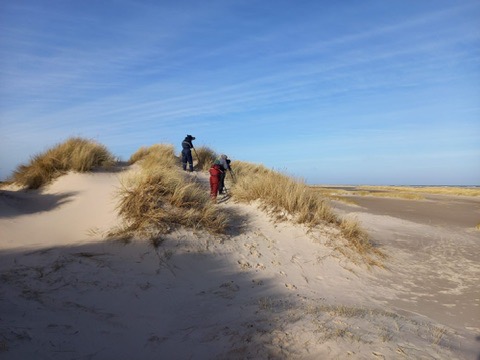 In search of Iceland Gull
In search of Iceland Gull
Passerine numbers, much like the Jackdaws, were also a bit lower today with fewer Snow Buntings (Snespurv), Eurasian Siskins (Grønsiskin) and Eurasian Skylarks (Sanglærke) being recorded. We did have a Fieldfare (Sjagger) and several Common Buzzards (Musvåge) attempt to migrate across Kattegat which was nice.
By the end of the morning, the wind severely picked up at began to cover our gear with sand. The ride back to the station was not super easy today but it was still nice to be out in the sun!
The remainder of the day was fairly quiet around the station with the only other major project being the entering of the daily data from the morning and followed by the first deep clean of the apartment of the spring season. Tomorrow is forecasted to be even more windy than today so for now the volunteers are preparing for another cold morning of counting! And so, another day at Skagen Fuglestation passes, what will tomorrow bring – we will have to wait and see.
Link to today´s observations in Dofbasen in the Skagen area
Sum of the Raptors in the area based on observations typed into Dofbasen.
Highlights from the observation:
- Iceland Gull (Hvidvinget Måge) - 1 2k
- Guillemot (Lomvie) - 468
- Black-legged Kittiwake (Ride) - 48
- Red-throated Diver (Rødstrubet Lom) - 200+
People: Lucas Corneliussen, Simon Sigaard Christiansen, Cora Köberle, Janna Ouedraogo, Roman Spilldooren.
A mix of wind and sun
Today was a windy day. Therefore, we had to observe the birds from underneath the dune top. Our observation started around 7:10 in the morning. In the beginning it was foggy far out the ocean and much sand was in the air. Due to the wind there were waves that made it hard to see resting ducks. The birds were also not happy about the conditions Therefore, we saw many migration attempts, but many of the birds headed back after a short while on the ocean.
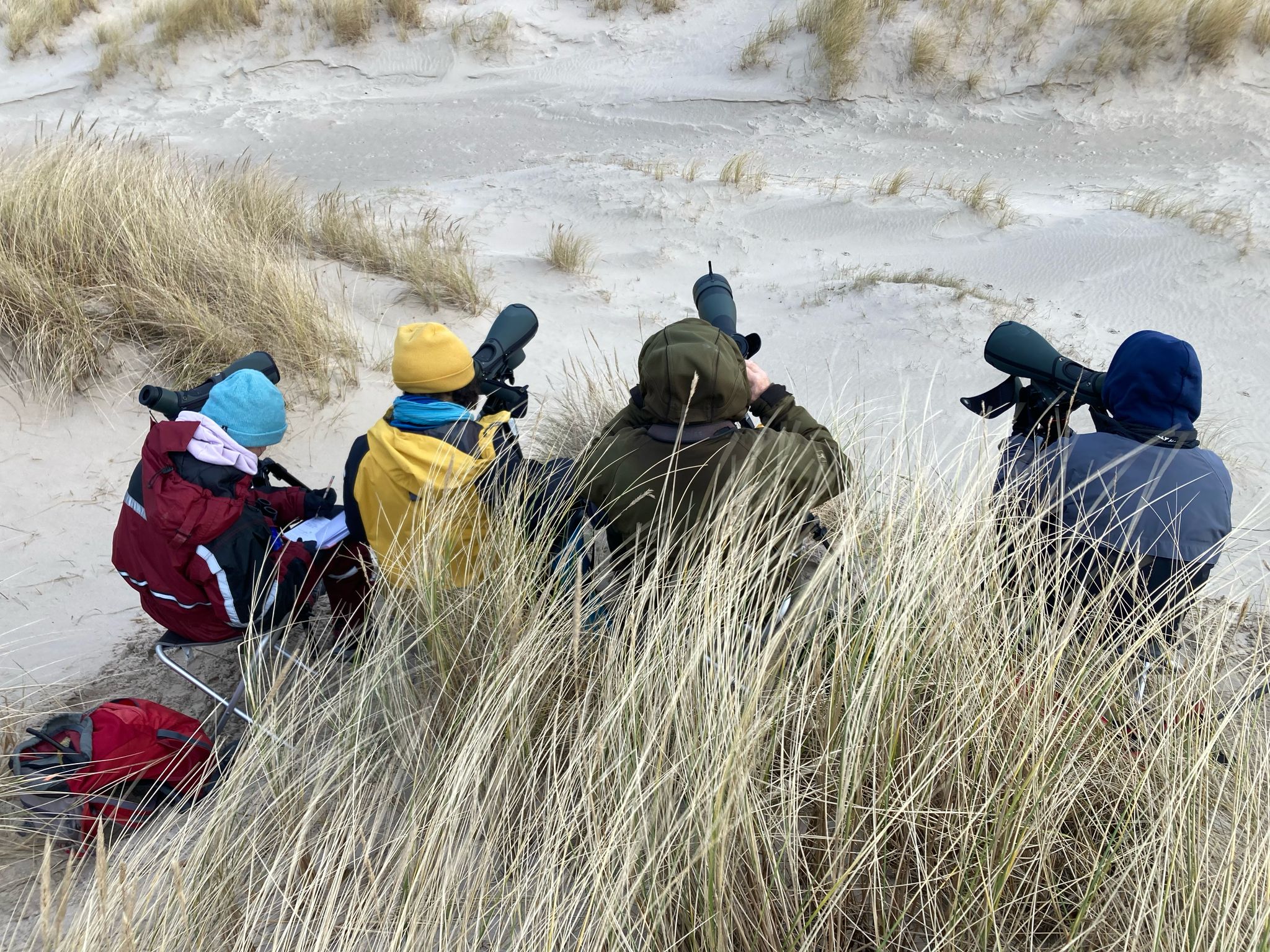
Observing in the dunes
After a while the sun came out and the circumstances got better. The colors occurred very beautiful- the white of the breaking waves, the grey-yellowish sanddunes with green and yellow grass on it, the dark blue of the ocean together with the paler blue of the sky- all gleaming in the sun. We had some time to look at the different plumages of the resting great crested grebes (Toppet Lappedykker). Subsequently a group of snow buntings (Snespurv) flew directly in front of us and showed nicely in the sun.

Dune atmosphere
In the last two hours some kittiwakes (Ride) occurred. Knud explained us how to distinguish them from common gulls (Stormmåge) if they are far away. I am looking forward to apply this in the following days.
A species that surprised us with high numbers was the red-throated-diver (Rødstrubet Lom). In the last two hours we counted over 167 of them.
With these great observations we forgot that it was a bit cold and the time went on very quickly.
In the afternoon we baked an apple cake. After that we checked the netlanes for the ringing- which will start in some weeks. While checking the lanes we found many interesting animals. Directly at the beginning we found an adder (Vipera berus) that was bathing in the sun. Than we found a moth called dotted border (Agriopis marginaria) and a moor frog (Rana arvalis). They may stand for the beginning spring. We are curious which animals we will see in the following weeks.
Link to today´s observations in Dofbasen in the Skagen area
Sum of the Raptors in the area based on observations typed into Dofbasen.
Highlights from the observation:
- Glaucous Gull (Gråmåge) - 1
- many red-throated-divers (Rødstrubet Lom) - 167
- some kittiwakes (Rides) - 8
People: Roman Spildooren, Janna Ouedraogo, Cora Koeberle, Lucas Corneliussen and Knud Pedersen
The first count of the season.
Today was our first official migration counting day. The day started with a lot of fog but after a good hour it cleared up completely and the sun even peeped through the clouds. We met Knud for the first time who helped us with the counting protocols and some determiation of some distant seabirds.
It was nice that sombody with so much experience could teach us on our first day. Knud found our first rarity of the counting season, a European Shag or Topskarv in Danish. We counted the large groups of resting sea ducks consisting of, Velvet Scoter (Fløjlsand), Common black scoter (Sortand9 and Eider's (Edderfugl). Far above Skagerrak and Kattegat a whole bunch of by; Guillemots (Lomvie), Red-throated Diver's (Rødsrubet Lom), Goldeneye (Hvinand) and Gannet's (Sule) passed by. Inland, large flocks of Jackdaws (Allike) formed and migrated north. And the first Hen harier (Blå kærhøg) and Common buzzard's (Muavåge) passed through.
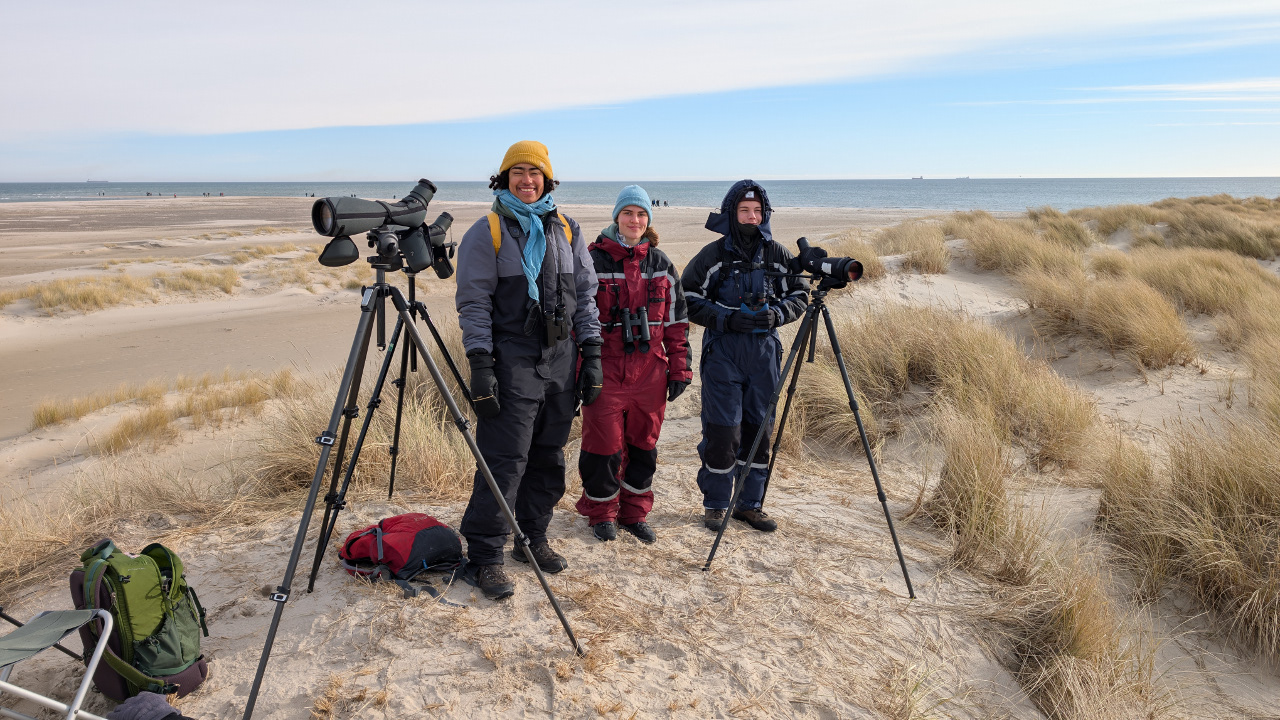 New team out on Worlds End 3. Photo: Knud Pedersen
New team out on Worlds End 3. Photo: Knud Pedersen
You can read a presentation of us new volunteers elsewhere on this webisite on this link.
Around 10:30 AM the migration slowed down but we used our time well and Knud taught us the difference between Adult and Juvenile Buzzard's (Musvåge) and the ageing of hen Harrier's (Blå kærhøg). Back at the Lighthouse, we enjoyed last night's surplus pasta carbonara for lunch. We made a short attempt for a seawatch in the afternoon but it did not yield too much news. We heard that the Crane's (Trane) were on their way north in large numbers so we are looking forward to that tomorrow!
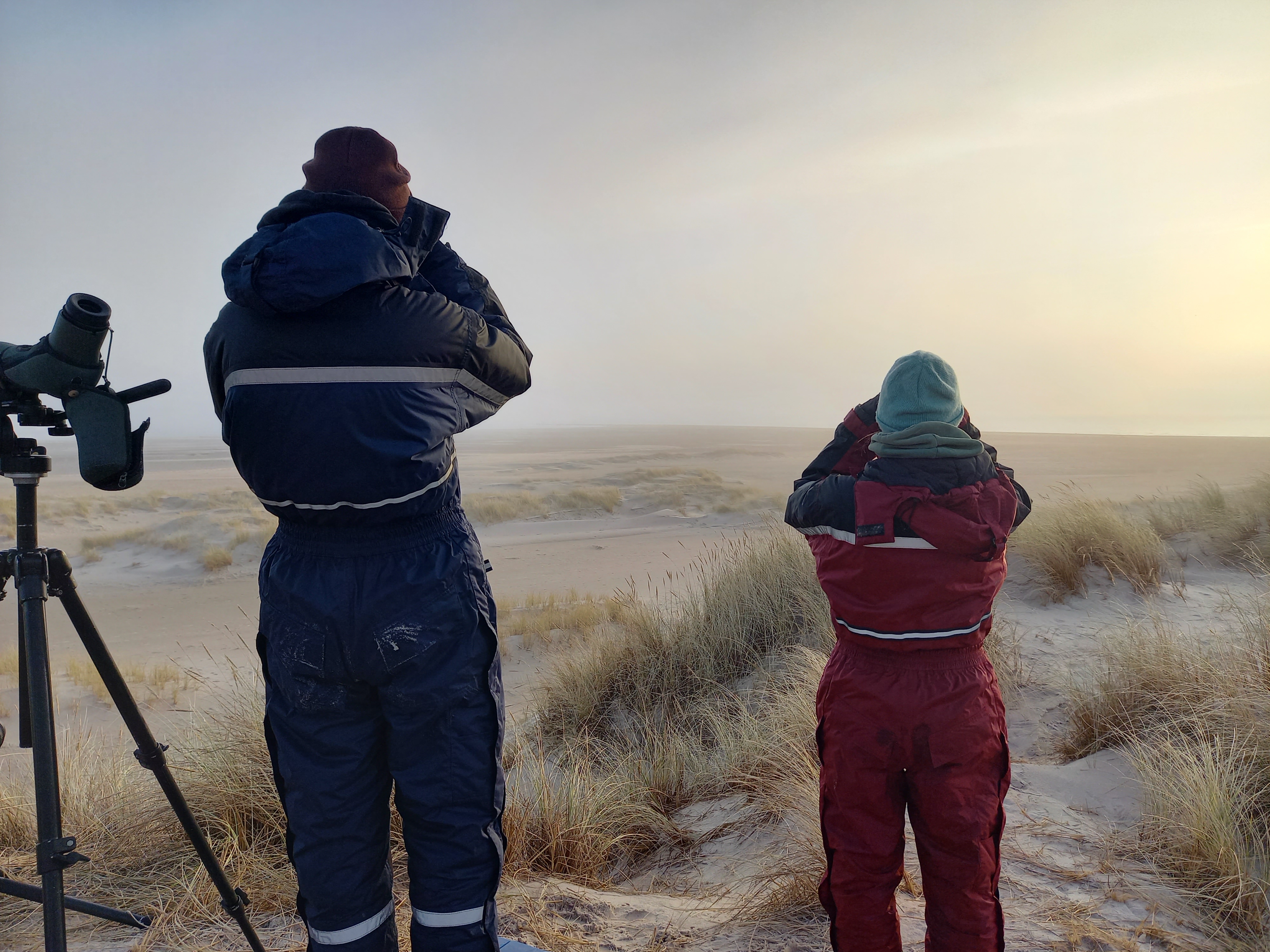 Scanning through the mist
Scanning through the mist
Highlights from the observations:
European Shag (Topskarv)
Link to todays observations in Dofbasen from the Skagen area
Sum of the Raptors in the area based on observations typed into Dofbasen.
People: Roman Spildooren, Janna Ouedraogo, Cora Koeberle, Lucas Corneliussen and Knud Pedersen
